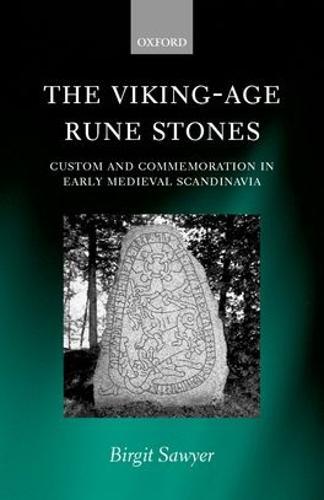Overview
There are over 3000 runic inscriptions on stone made in Scandinavia in the late Viking Age. This book is the first attempt by a historian to study the material as a whole. The analysis reveals significant regional variations that reflect different stages in the process of conversion, and the growth of royal power. Many monuments were declarations of faith or manifestations of status; but virtually all reflect inheritance claims, and cast unexpected light on the prehistory of the inheritance customs found in later Scandinavian law codes. The results of this analysis make a significant contribution to understanding developments in other parts of the Germanic world, as well as Scandinavia. The inclusion of a digest of the data-base on which this book is based will facilitate further study of this rich vein of evidence.
Full Product Details
Author: Birgit Sawyer (, Professor of History, Norges Teknisk-Naturvitenskapelige Universitet, Trondheim)
Publisher: Oxford University Press
Imprint: Oxford University Press
Dimensions:
Width: 16.40cm
, Height: 2.10cm
, Length: 24.20cm
Weight: 0.710kg
ISBN: 9780198206439
ISBN 10: 0198206437
Pages: 300
Publication Date: 07 December 2000
Audience:
Professional and scholarly
,
Professional & Vocational
Format: Hardback
Publisher's Status: Active
Availability: To order

Stock availability from the supplier is unknown. We will order it for you and ship this item to you once it is received by us.
Reviews
This book marks a big step forward in the study of commemorative runic inscriptions and late Viking-Age history. By assembling and analysing so much information from tenth- and eleventh-century rune stones the author has provided scholars with a wealth of readily accessible data for future research. By raising so many interesting questions she will also, as she hoped, have stimulated fellow workers to delve into that data. Saga-Book Extremely detailed analysis ... The Viking-Age Rune-Stones has many strengths. The result of years of painstaking work, it demonstrates an intimate knowledge of the late Viking-Age rune stone corpus and its background ... The Viking-Age Rune-Stones has brought a wealth of important data to the attention of the scholarly community. Saga-Book The secions on the patterns of social order and inheritance will make this book an indispensable example of runology applied to social history, a line of study with a future. It is worth buying for the careful tabulation of inscriptions and motifs alone. English Historical Review This is a stimulating book, challenging accepted interpretations and suggesting new sources for Viking Age social history. R.I. Page, Times Higher Education Supplement Thorough statistical coverage, backed up by a seventy page Catalogue ... her work puts the English-speaking reader for the frst time in possession of the basic information painstakingly recorded by Scandinavian scholars, as well as providing an entirely fresh and convincing explanation of the Viking Age corpus ... Birgit Sawyer [has] offered models of patient and dispassionate research in potentially exciting and contested areas. Tom Shippey, Times Literary Supplement
This book marks a big step forward in the study of commemorative runic inscriptions and late Viking-Age history. By assembling and analysing so much information from tenth- and eleventh-century rune stones the author has provided scholars with a wealth of readily accessible data for future research. By raising so many interesting questions she will also, as she hoped, have stimulated fellow workers to delve into that data. Saga-Book Extremely detailed analysis ... The Viking-Age Rune-Stones has many strengths. The result of years of painstaking work, it demonstrates an intimate knowledge of the late Viking-Age rune stone corpus and its background ... The Viking-Age Rune-Stones has brought a wealth of important data to the attention of the scholarly community. Saga-Book The secions on the patterns of social order and inheritance will make this book an indispensable example of runology applied to social history, a line of study with a future. It is worth buying for the careful tabulation of inscriptions and motifs alone. English Historical Review This is a stimulating book, challenging accepted interpretations and suggesting new sources for Viking Age social history. R.I. Page, Times Higher Education Supplement Thorough statistical coverage, backed up by a seventy page Catalogue ... her work puts the English-speaking reader for the frst time in possession of the basic information painstakingly recorded by Scandinavian scholars, as well as providing an entirely fresh and convincing explanation of the Viking Age corpus ... Birgit Sawyer [has] offered models of patient and dispassionate research in potentially exciting and contested areas. Tom Shippey, Times Literary Supplement
`the secions on the patterns of social order and inheritance will make this book an indispensable example of runology applied to social history, a line of study with a future. It is worth buying for the careful tabulation of inscriptions and motifs alone.' English Historical Review, Sept.01 `Sawyer ... brings half a lifetime's work, and many modifications of her original thesis, to an impressive consummation. All the available material is listed, classified and identified in a series of appendices and notes which will bring blessings on her head from anglophone researchers waiting for the completion of the general rune-text database.' English Historical Review, Sept.01 `This is a stimulating book, challenging accepted interpretations and suggesting new sources for Viking Age social history.' R.I.Page, Times Higher Education Supplement, 13 July 2001 `thorough statistical coverage, backed up by a seventy page Catalogue ... her work puts the English-speaking reader for the frst time in possession of the basic information painstakingly recorded by Scandinavian scholars, as well as providing an entirely fresh and convincing explanation of the Viking Age corpus ... Birgit Sawyer [has] offered models of patient and dispassionate research in potentially exciting and contested areas.' Tom Shippey, TLS




